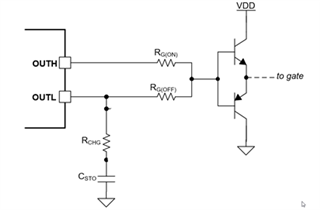Other Parts Discussed in Thread: ISO5852S
Hi,
I have some doubts related to the desat protection and associated soft turn off feature in the ISO5852S gate driver.
1. Generally when someone design a gate driver using ISO5852 with high current buffer in the output then a RC circuit is connected in between Vee and OUTL pins. what is the reason of connecting this RC circuit?
2. Sometime the desat protection of the gate driver like ISO5852S is connected to the device using an Opamp instead of connecting directly with the collector or drain of the device. Can you please provide me the advantages of doing so?
Thanks,
Gaurav


